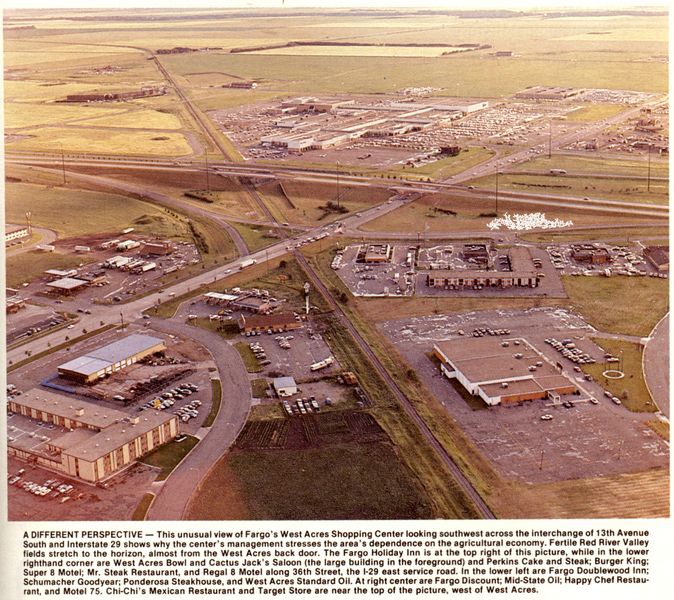 If you had no idea that Fargo has grown in leaps and bounds, let’s look back 25 years. In 1982, this photo was taken for the Binford Guide to commemorate the 10th anniversary of West Acres Mall. The mall is seen in the upper-center area of the photo — and beyond that are miles and miles of farmland. 45th Street, barely visible at the top edge (it was a dirt road then) is about a mile from I-29: today (see a Google Map), the green, lush farmland you see is almost entirely paved and filled with a zoo, the YMCA, the largest Scheels store in the world, a 6-story office building (in which the Infomercantile webserver lives), and numerous other offices, strip malls, big-box retailers, and apartment buildings. The growth of the Fargo area is dumbfounding sometimes; when they talk about rural areas shrinking in population, it’s because they’re coming to the bigger cities. One thing I find most interesting, from both the photo and the aerial map, is the identification of what’s new versus what’s old based on the railroad line that used to run through this part of town. Buildings built on the diagonal were there before the tracks were removed; buildings on the north-south lines are new.
If you had no idea that Fargo has grown in leaps and bounds, let’s look back 25 years. In 1982, this photo was taken for the Binford Guide to commemorate the 10th anniversary of West Acres Mall. The mall is seen in the upper-center area of the photo — and beyond that are miles and miles of farmland. 45th Street, barely visible at the top edge (it was a dirt road then) is about a mile from I-29: today (see a Google Map), the green, lush farmland you see is almost entirely paved and filled with a zoo, the YMCA, the largest Scheels store in the world, a 6-story office building (in which the Infomercantile webserver lives), and numerous other offices, strip malls, big-box retailers, and apartment buildings. The growth of the Fargo area is dumbfounding sometimes; when they talk about rural areas shrinking in population, it’s because they’re coming to the bigger cities. One thing I find most interesting, from both the photo and the aerial map, is the identification of what’s new versus what’s old based on the railroad line that used to run through this part of town. Buildings built on the diagonal were there before the tracks were removed; buildings on the north-south lines are new.
Tag: fargophilia
Inside Black’s Store Without A Name
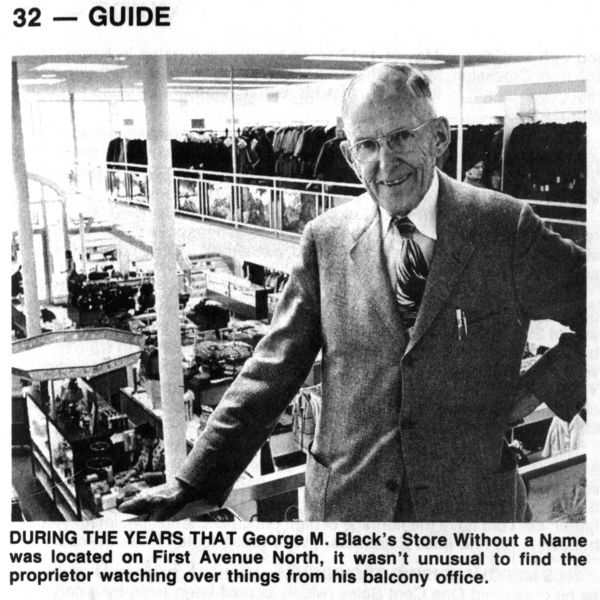
Meet George M Black. The big building on Broadway, the one sprouting up from Elm Tree Square today, bear this gentleman’s name. In 1912, Black opened up his own department store — Black’s — on that spot and began buying up the surrounding property. Black sold his store to Sears and used the money to build the Black Building — but he wasn’t out of the department store racket yet.
The photo above, scanned from a Binford Guide article about the sale of the Black Building in ’86, is of Black overlooking his post-1929 department store. Black had sold his previous store to Sears lock, stock, barrel, and name, resulting in a guy with retail smarts but no catchy name anymore. His solution: call his new shop The Store Without A Name. The marketing was witty — he held a contest to pick a new name, but to everyone’s surprise the majority of the votes went to keep the department store nameless. One bright suggestion was to abbreviate it to the ‘Swan’, but that didn’t have the sticking power of the unnammed shop. The Store Without A Name is now the parking lot next to the Avalon; the Black Building ceased being a department store when Sears moved out to the mall in ’76.
The Last Binford Guide
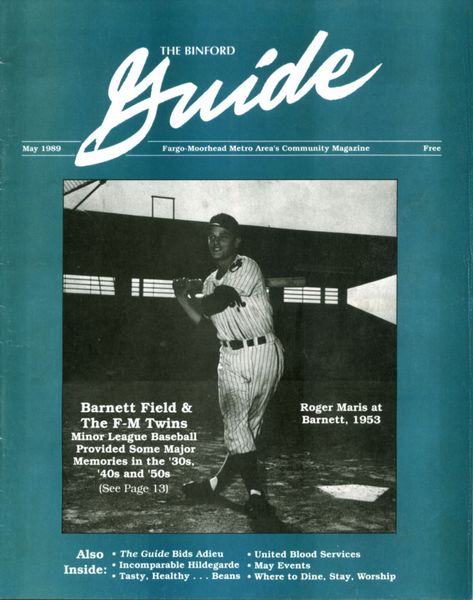 Howard Binford was a journalism icon in the Fargo-Moorhead area during the 60s and 70s, training the media personalities of the future and publishing his own magazine. Late in life, Binford starting publishing his Howard Binford’s Guide in 1968, interviewing a series of locals who were quite obviously Binford’s friends, church acquaintances, advertisers, and co-chairs on local boards. Still, he was a bright and entertaining editorialist, and the magazine was actually useful to non-locals on holiday and residents alike.
Howard Binford was a journalism icon in the Fargo-Moorhead area during the 60s and 70s, training the media personalities of the future and publishing his own magazine. Late in life, Binford starting publishing his Howard Binford’s Guide in 1968, interviewing a series of locals who were quite obviously Binford’s friends, church acquaintances, advertisers, and co-chairs on local boards. Still, he was a bright and entertaining editorialist, and the magazine was actually useful to non-locals on holiday and residents alike.
Looking forward, Binford began to pass control to his assistants in 1984, sold the magazine to a local publisher in 1986, but his health got the better of him at the end of 1988 and he passed away. Without Binford, the Guide ended publication with the May 1989 issue. The Guide was clearly valuable to the community: most of the magazines I’ve collected were aquired in large lots — people saved years and years of the guide in their basement. I’ve got almost the entire 1980s uploaded, a good part of the 70s, but those 1/8th-size pre-1975 Guides are tough to find.
Buckskin Harry, Fargo TV Cowboy
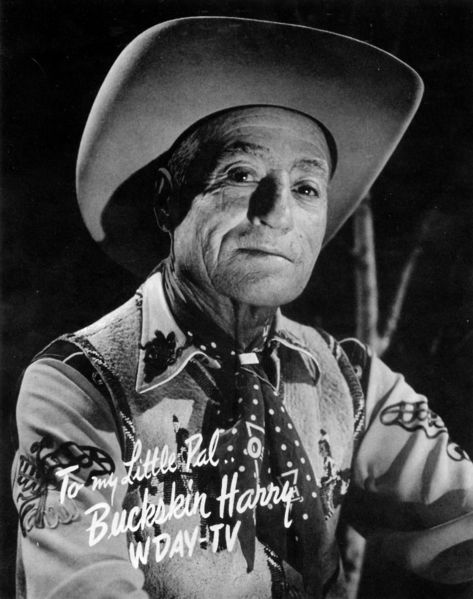 Buckskin Harry, as far as I can tell at this time, was a local television personality here in Fargo. Back in the day, local television stations did a lot more local programming than just the news; a lot of the national kids’ shows like Bozo the Clown had its roots in local TV stations. Even into the 1980s local stations had thematic characters do intros and commercial bumpers for horror movies.
Buckskin Harry, as far as I can tell at this time, was a local television personality here in Fargo. Back in the day, local television stations did a lot more local programming than just the news; a lot of the national kids’ shows like Bozo the Clown had its roots in local TV stations. Even into the 1980s local stations had thematic characters do intros and commercial bumpers for horror movies.
We found this photo in a 1950s magazine, so it gave us a pretty good idea of about when ‘ol Buckskin graced the boob-tube. Our first resource was my grandparents — Grandpa Vernon remembered Harry on TV in the 1950s, but Grandpa was nurturing a new family around that time and wasn’t watching mid-afternoon kids’ programming.
Going through a 1955 Fargo Forum, I found some more specific information: Buckskin was on at 4 in the afternoon, an excellent timeslot lead into by Pinky Lee and Howdy Doody — and Buckskin’s show ran for an hour and fifteen minutes. I’m still doing my digging (my research method consists of doing very little, randomly encountering information…it works pretty well, actually), but if anybody out there remembers Buckskin, I’d appreciate any info.
When Flair Was King
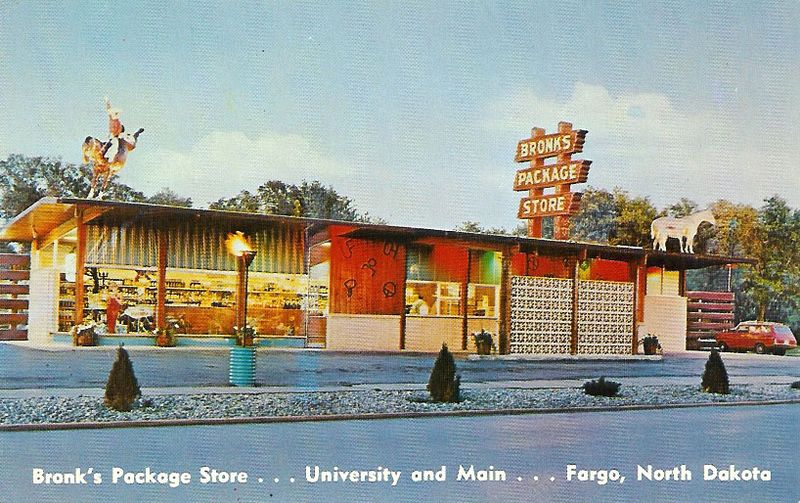 About a month ago, I drove past that ugly modern office building on the corner of Main and University, and struggled to remember what was there before. Then, I found this postcard, and memories rushed back in. No, I don’t think I was ever in Bronk’s (we were a Polar Package Place family; it was closer to our home), but its central location in Fargo and garish exterior would make it hard to forget. I’m going to look through my archives and see if I can dig up any more on Bronk’s, but I don’t remember seeing anything about it recently. Today, garish exteriors are reserved for children’s restaurants and theme buffets — the interior of a liquor store isn’t inherently anything, let alone to be ‘themed’ to attract customers. Modern stores aim for neutral efficiency, and ‘vice’ stores want to project professionalism lest they be called uncouth…but back in the day, when someone said to stop at the liquor store with the cowboy on top, you darn well knew where to go. Bronk’s disappeared in the late 80s by my recollection, and was replaced by a law office building. No cowboys on the top of the law offices, sadly.
About a month ago, I drove past that ugly modern office building on the corner of Main and University, and struggled to remember what was there before. Then, I found this postcard, and memories rushed back in. No, I don’t think I was ever in Bronk’s (we were a Polar Package Place family; it was closer to our home), but its central location in Fargo and garish exterior would make it hard to forget. I’m going to look through my archives and see if I can dig up any more on Bronk’s, but I don’t remember seeing anything about it recently. Today, garish exteriors are reserved for children’s restaurants and theme buffets — the interior of a liquor store isn’t inherently anything, let alone to be ‘themed’ to attract customers. Modern stores aim for neutral efficiency, and ‘vice’ stores want to project professionalism lest they be called uncouth…but back in the day, when someone said to stop at the liquor store with the cowboy on top, you darn well knew where to go. Bronk’s disappeared in the late 80s by my recollection, and was replaced by a law office building. No cowboys on the top of the law offices, sadly.
Rusk Auto-House Found
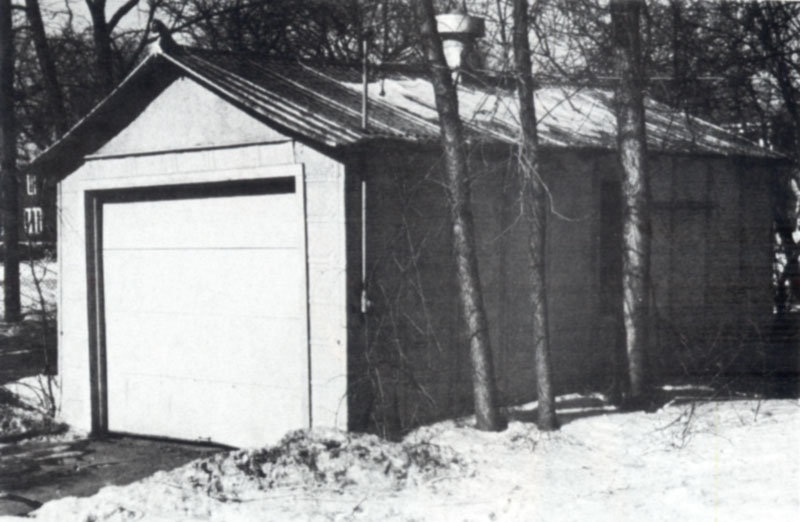 When I first learned about the Rusk Auto-House, I discovered that one was placed on the National Register of Historic Places, Building #87002634 — but the address didn’t make sense. I walked around that block, and found nothing but parking lot. I assumed it was torn down quite some time ago, but in going through my Binford Guide archive I found a photo of that very Rusk. Located on a house’s driveway exiting on to 7th avenue, a half block west of Broadway and facing St. Mary’s Cathedral, sat this pressed-steel garage. That was in 1988; the garage must have disappeared not long after, as I don’t ever remember anything on that corner except parking lot.
When I first learned about the Rusk Auto-House, I discovered that one was placed on the National Register of Historic Places, Building #87002634 — but the address didn’t make sense. I walked around that block, and found nothing but parking lot. I assumed it was torn down quite some time ago, but in going through my Binford Guide archive I found a photo of that very Rusk. Located on a house’s driveway exiting on to 7th avenue, a half block west of Broadway and facing St. Mary’s Cathedral, sat this pressed-steel garage. That was in 1988; the garage must have disappeared not long after, as I don’t ever remember anything on that corner except parking lot.
Howard Binford’s Guide
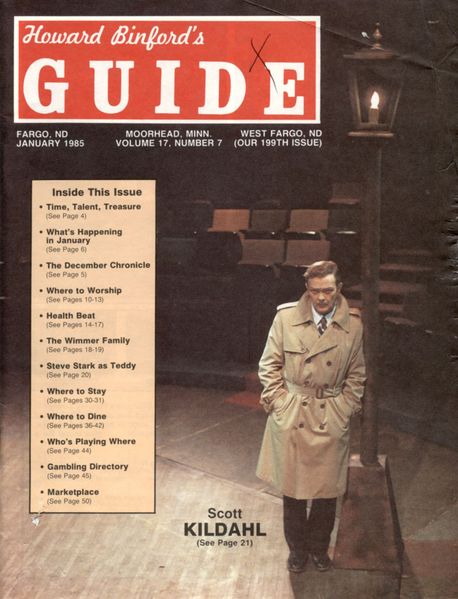 Howard Binford was a journalism instructor at Moorhead State University when he started his magazine: Howard Binford’s Guide, a free publication for tourists or other non-locals providing handy lists of places to eat and sleep, who’s performing in town, and other things of interest in the Fargo-Moorhead area. The magazine ran from 1968 until Binford died in 1989, with some changes throughout (as you’d expect in over 20 years of publishing), but the magazine kept its content and tone through the years. The magazine was sold to Kaye’s printing in 1986, and after Binford’s passing Kaye’s continued publishing as “Fargo-Moorhead Magazine” — after which they, themselves, were bought by the Fargo Forum. The magazine started in ’68 by a teacher continues today through the largest regional publisher in the Red River Valley.
Howard Binford was a journalism instructor at Moorhead State University when he started his magazine: Howard Binford’s Guide, a free publication for tourists or other non-locals providing handy lists of places to eat and sleep, who’s performing in town, and other things of interest in the Fargo-Moorhead area. The magazine ran from 1968 until Binford died in 1989, with some changes throughout (as you’d expect in over 20 years of publishing), but the magazine kept its content and tone through the years. The magazine was sold to Kaye’s printing in 1986, and after Binford’s passing Kaye’s continued publishing as “Fargo-Moorhead Magazine” — after which they, themselves, were bought by the Fargo Forum. The magazine started in ’68 by a teacher continues today through the largest regional publisher in the Red River Valley.
Each Guide had a profile or interview with some local dignitary; hardly a whos-who of international fame, Binford wrote about an interesting group of local religious leaders, businessmen, regional government, and amateur performers.